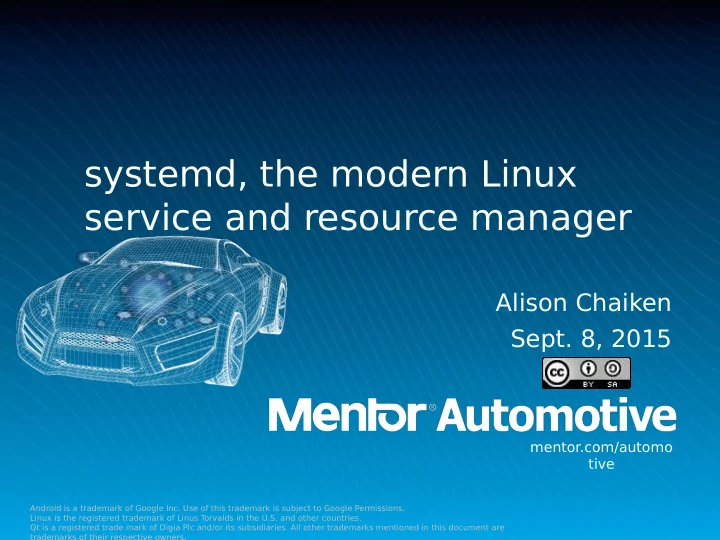

systemd, the modern Linux service and resource manager Alison Chaiken Sept. 8, 2015 mentor.com/automo tive Android is a trademark of Google Inc. Use of this trademark is subject to Google Permissions. Linux is the registered trademark of Linus T orvalds in the U.S. and other countries. Qt is a registered trade mark of Digia Plc and/or its subsidiaries. All other trademarks mentioned in this document are trademarks of their respective owners.
Philosophy of systemd ● Extract duplicate functionality from daemons and move it to systemd core or kernel. ● Replace /etc scripts with declarative config files. ● Expose newer kernel APIs to userspace via a simple interface. 2 2
systemd is: ● modular ; ● asynchronous and concurrent ; ● described by declarative sets of properties; ● bundled with analysis tools and tests; ● supplied with a fully language-agnostic API. 3 3
init.d scripts ⇒ systemd unit properties ● Unit's action and parameters: ExecStart= ● Dependencies: Before=, After=, Requires=, Confmicts= and Wants=. ● Default dependencies: – Requires= and After= on basic.target; – Confmicts= and Before= on shutdown.target. ● T ypes of unit fjles: service, socket, device, mount, scope, slice, automount, swap, target, path, timer, snapshot 4 4
Example: Automotive Message Broker From /lib/systemd/system/ambd.service: # ambd systemd service unit fjle [Unit] Description=Automotive Message Broker After=syslog.target [Service] T ype=dbus BusName=org.automotive.message.broker ExecStart=/usr/bin/ambd [Install] WantedBy=multi-user.target 5 5
Example: Make the gdp-hmi-controller only start when weston is ready From: Jonathan Maw <jonathan.maw@codethink.co.uk> [ . . . ] --- /dev/null +++ b/recipes-demo-hmi/genivi-demo-platform-hmi/gdp-hmi- launcher2/StartLauncher.path +[Unit] +Description=GENIVI Start Launcher when weston is ready +Requires=weston.service +After=weston.service +[Path] +PathExists=/var/run/user/0/wayland-0 6 6
sysVinit runlevels ≈ systemd targets Targets are synchronization points . ● Check /lib/systemd/system/runlevel?.target symlinks: ● – multi-user.target (runlevel 3) – graphical.target (runlevel 5) Select boot-target : ● – via /etc/systemd/system/default.target symlink; – appending number or systemd.unit=<target> to bootargs. 7 7
Illustration: systemd-bootchart and custom targets Courtesy Marko Hoyer, ADIT. 8 8
Custom T argets in GENIVI's Lifecycle Management Node Startup Controller LUC = Last User Context 9 9
Hierarchy of unit fjles for system and user sessions Organized into system and user units ● /lib/systemd/system: systemd upstream defaults for system- ● wide services /etc/systemd/system: local customizations by override and ● extension /lib/systemd/user : systemd's upstream defaults for per-user ● services $HOME/.local/share/systemd/user for user-installed units ● 'drop-ins' are run-time extensions ● 10 10
Illustration:Tizen Multi-user system Source: Dominig ar Foll, “Tizen 3 IVI Architecture Multi User App FW”, FOSDEM 2014 11
Tizen Login Manager and User Sessions Source: Dominig ar Foll, “Tizen 3 IVI Architecture Multi User App FW”, FOSDEM 2014 12
using the systemd journal Easily pushed to a remote. ● Can be cryptographically 'sealed'. ● Configurable max size and rotation. ● Simple log-reading tools are scriptable: ● journalctl -xn journalctl -p err journalctl -u cron journalctl -o json-pretty systemctl status systemctl is-failed bluetooth systemctl --failed 13 13
Both systemd journal and DLT: ● are modular and extensible. ● support pushing data to AF_INET socket. ● can share data with legacy syslog. ● natively output binary formats. → Linking systemd and DLT involves: translating binary formats; – handshaking; – synchronization. – ● Performed by remote? 14 14
simplifjes access to kernel's security, resource and watchdog controls Including Capabilities, Watchdog, Cgroups and ● kdbus (still a 'coming attraction') Kernel features confjgurable via simple ASCII ● options in unit fjles. Encourages creation of system policies via unit ● templates. 15 15
granular resource control: systemd and cgroups ● cgroups: a kernel-level mechanism for allocating storage, memory, CPU and network. ● slices are groups of daemons whose resources are managed jointly. ● systemd scopes are resultant groups of user processes. ● Can set BlockIOWeight, IOSchedulingPriority, OOMScoreAdjust, CPUShares, MemoryLimit … Tomorrow: “An introduction to Control Groups” 16 16
systemd and security: granular encapsulation via kernel's capabilities ● CapabilityBoundingSet ● PrivateTmp, PrivateDevices, PrivateNetwork ● JoinNamespaces ● ProtectSystem (/usr and /etc), ProtectHome ● ReadOnlyDirectories, InaccessibleDirectories ● systemd-nspawn: systemd's native containers 17 17
systemd's watchdog support ● Provides simple confjguration of soft or hard watchdogs. ● RuntimeWatchdogSec sets a timer for petting the dog. ● ShutdownWatchdogSec sets a timer to force reboot if shutdown hangs. 18 18
Summary ● Adaptation to systemd requires considerable thought. ● Uniform dependency language is attractive. ● Managing resources, security and and watchdogs is potentially simplifjed. ● Backwards compatibility eases transition, but project moves quickly. 19 19
Resources ● Man pages are part of systemd git repo. ● freedesktop.org: systemd mailing list archives and wiki ● Poettering's 0pointer.de blog ● ➟ At wayback machine: “Booting up” articles ● Neil Brown series at LWN ● ➟ Fedora's SysVinit to systemd cheatsheet ● Poettering's 'What's new' talk from FOSDEM 2015 ● Josh Triplett's Debconf talk video ● Linux Action Show interviews with Mark Shuttleworth and Lennart Poettering ● A bunch of videos and slides linked at my website 20 20
resource utilization of systemd itself systemd-211 in Poky includes 17 packages = 8 MB. ● systemd-219 builds 90 MB of executables (not all needed). ● minimal build = systemd, udevd and journald. ● Memory (RSS) of fully featured build: ≈9 MB; minimum build ≈5 MB. ● Features added/removed via './configure'. ● 21 21
Recommend
More recommend